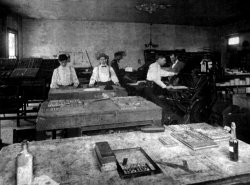
MAY CONTAIN NUTS

Search Shorpy
SHORPY ART

Framed or unframed, desk size to sofa size, printed by us in Arizona and Alabama since 2007. Explore now.
Join and Share
Ad-Free Shorpy
Shorpy is funded by you. Patreon contributors get an ad-free experience.
Learn more.

Recent comments
- Recent view
- Hudson’s Big Store
- Say what??
- Grapes?!
- A Beautiful Moment
- Such joy
- Bethune-Cookman University today...
- Yellow sky at morning
- Side Winder
- Air Quality?
- Sojourner Truth riot
- None were so blind(ed)
- The less famous sister
- Good ol' days?
- Rise and Fall
- Goo Goo Ga Joob
- Ticket Retention
- Not the only one
- Vagaries of War
- Killed by Amtrak
- Back to the Future
- Wanted --
- If you can't stand the light
- Centralized Traffic Control, I believe
- What's really happening
- Heckuva remote control!
- Sometimes — Things Go Bump!
- I SEE THE LIGHT
- Union Switch and Signal Company
- Get That Light Out Of My Eyes
Member Photos
The Shorpy
Print Emporium
Print Emporium
Search Shorpy
Search results -- 30 results per page
- Dolls: 1938
- November 1938. Donaldsonville, Louisiana. "Young girl buying doll from concession manager at the state fair." ... Posted by Dave - 06/04/2008 - 5:59pm -
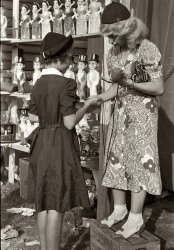
- Fordable Housing: 1940
- December 1940. Alexandria, Louisiana. "Construction worker's trailer (home-made house car). He has a job ... Posted by Dave - 07/21/2019 - 4:52pm -
![Fordable Housing: 1940 December 1940. Alexandria, Louisiana. "Construction worker's trailer (home-made house car). He has a job at Camp Livingston." Acetate negative by Marion Post Wolcott. View full size.
Model T-railer homeI've heard of living in your car before, but this takes it to a whole 'nother level.
Proto-AirstreamLovely work on this early camper! I wonder what it was like inside?
Unsafe at any speedAnd Ralph Nader though the Corvair was dangerous!
Not much peripheral visionLooking down the road just a few years to wraparound windshields.
[Or bay windows. - Dave]
True GritI am not sure how you would ever drive that, but I am sure the man who built it was as sharp as can be and as tough as nails. Nothing-he-couldn't-do type of fella.
A man's man.
(The Gallery, Cars, Trucks, Buses, M.P. Wolcott)](https://www.shorpy.com/files/images/SHORPY-8c14295a.thumbnail.jpg)
- Student Nurse: 1942
- Lydia Monroe of Ringold, Louisiana, is a student nurse at Provident Hospital in Chicago, Illinois. Her ... Posted by Ken - 08/08/2012 - 8:19pm -
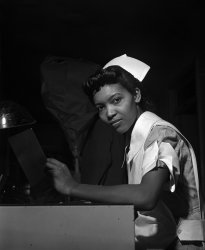
- Old Folks at Home: 1935
- ... but it appears to fit that pattern.
However, in Louisiana at Transylvania Plantation just south of Lake Providence, blacks who ... Posted by Dave - 07/05/2009 - 2:04am -
![Old Folks at Home: 1935 October 1935. Brown County, Indiana. Prospective Resettlement Administration clients whose property has been optioned by the government. View full size. 35mm nitrate negative by Theodor Jung for the Farm Security Administration.
Resettlement?Can someone decode what the caption means? Resettlement clients? Property optioned? It sounds like their farm dustbowled up and the Roosevelt government is buying them out, but I'd like the official word... Thanks!
[Wikipedia article on the Resettlement Administration. - Dave]
Brown County INBrown County has the largest Indiana state park and part of the Hoosier National Forest. Brown County has by far the highest concentration of forested land of any of Indiana's 92 counties with nearly 90% coverage and almost no large farms at all. I think these people we relocated to help create these great parks.
http://www.fs.fed.us/r9/hoosier/docs/history/history.htm
Resettlement AdministrationThe resettlement of tens of thousands of people occurred through government action in the 1930s. In some cases it was for projects like the Tennessee Valley Authority where vast areas of bottom lands were flooded and the owners of the land, many of them having families that dated to the Revolutionary War period, were "resettled". In other cases, people lived on what the government determined to be submarginal lands and they were bought out and given the option of settling in a "homestead project" such as the ones developed by the FSA and, earlier, the Resettlement Administration. I don't know the particular history of Brown County, Indiana, where clients were "optioned", but it appears to fit that pattern.
However, in Louisiana at Transylvania Plantation just south of Lake Providence, blacks who had lived on the plantation since the Civil War were evicted by the FSA and white farmers were brought onto the land. The only evidence of this is determined by the photographs made by Russell Lee. There is no reliable history, at this point, that tells us exactly what took place and why (except for the photographic evidence). The result of the removal of hundreds of black tenants, their houses turned over to the new arrivals as well as their churches and community center, was an embittered and angry black population. They formed the nucleus of a particularly militant civil rights group based in Lake Providence. It appears that throughout the south the projects set up by the FSA had very long lasting implications.
The government had determined that FSA projects would be segregated, at the instigation of politicians, which was a profoundly different pattern for sharecroppers in particular who lived in racially mixed arrangements on the land. the result, time and again of this "resettlement" in the south was that whites and blacks were separated and concentrated in isolated communities. the black communities were often the font of civil rights work in their region. The white communities such as the Dyess Project in Arkansas were the centers of the Ku Klux Klan.
Here is a website that outlines some of our research:
http://www.siu.edu/%7ejadams/fsa/
(The Gallery, Great Depression, Rural America, Theodor Jung)](https://www.shorpy.com/files/images/8a14048u.thumbnail.jpg)
- Chretien Point: 1938
- ... Point Plantation, Sunset vicinity, St. Landry Parish, Louisiana. Structure dates to 1831." Photo by Frances Benjamin Johnston. View ... Posted by Dave - 02/27/2014 - 12:32pm -
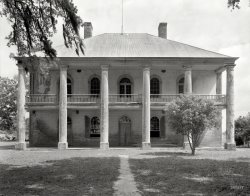
- Gone Fishin'
- ... June 1940. Cajun boys fishing in the bayou near Schriever, Louisiana, not far from the Terrebonne Parish School. View full size. 35mm ... Posted by Dave - 09/12/2012 - 6:10pm -

- Hazy River: 1905
- ... about YOU, Dave.
The wintry weather is rare in south Louisiana, though the state's northern parishes see it about once a year. New ... Posted by Dave - 10/16/2020 - 11:09am -
![Hazy River: 1905 New Orleans circa 1905. "Mississippi River from Hennen Building." Panorama made from four 8x10 inch glass negatives. Detroit Publishing Company. View full size.
Shorpy business buildingEvery morning a few new photos in storefront window. Those were the days.
PanoWhat a great job stitching those four images together. When I embigulate and then scroll back and forth, left and right, I feel the whole image wrap around me. I can’t believe it’s flat. Exhilarating.
Smoke 'em if ya got 'emWith all those chimneys belching black smoke, it's a wonder the rooftop snow looks so white.
[Um, no snow. Sometimes I wonder about you people ... - Dave]
Sometimes I wonder about YOU, Dave.
The wintry weather is rare in south Louisiana, though the state's northern parishes see it about once a year. New Orleans' last snowfall, in 2004, was a dusting that came nine months before Hurricane Katrina struck. The record snowfall for the city is about 5 inches, recorded Dec. 30, 1963.
It sure looks like snow, melted in some places, and may have been the rare event that triggered the photos. (Look at the rooftop in the center foreground).
However, I've been to Mardi Gras in NOLA (in Feb, I think) when it SEEMED cold enough to snow. But shells make perfect sense the white would reflect the heat. I still stand by my comment that it's a wonder the rooftops are still so white with the smoke.
Griswold JewelerAd for Griswold Jeweler
Snowy RooftopsWhat appears to be snow, as mentioned by a commenter below, is actually white stone or crushed shell, used to keep the buildings cooler in summer by reflecting the sun's heat up.
The clarity of these old-time shots is astonishing.
(Panoramas, DPC, New Orleans)](https://www.shorpy.com/files/images/SHORPY-New_Orleans_4Panorama-1.thumbnail.jpg)
- Canal Street: 1907
- ... date the photo to no later than 1904. In that year, by Louisiana law, all vestibules had to be enclosed. I suspect it dates from ... Posted by Dave - 10/15/2020 - 10:50am -
![Canal Street: 1907 New Orleans circa 1907. "Canal Street." Center stage: A Streetcar Named Prytania. Composite image made from two 8x10 inch glass negatives. View full size.
Expensive healthcareIt is probably no coincidence that a Loan Office is in the same building as the National Dental Parlors.
Tooth-hurty1907 dentistry on an industrial scale ... now there's an appealing idea! "Those are screams of joy, kids -- no worries!" My mother recalls her 1930s visits to a dentist named Dr. Carpenter. Guess what sort of tools he used?
Details about the photoOf the five tracks in this view, only the two outer tracks were dual gauge. Actually, you can see it, just vaguely. It's the right-hand rail that was dual, and it looks like the railhead is wider. That's the effect of the double right-hand railheads next to each other (with just wheel flange clearance between them).
We can date the photo to no later than 1904. In that year, by Louisiana law, all vestibules had to be enclosed. I suspect it dates from 1900-1904.
[It was taken the same day as this view, whose negative is marked with a copyright date of 1907. - Dave]
The car with the Prytania clerestory sign was presumably assigned usually to that route, but is not at that moment on that route. A Prytania car would not be on that track. Note the Special sign hanging from the dash. I believe the car is on some kind of special assignment, perhaps a charter.
A Streetcar Named PrytaniaAs cool a photo as I've seen in a long time. Thank you, Dave
Drip - Drip - DripEarly streetcars and interurbans did not have sealed wheel and axle bearings. The result was that lubricating oil leaked out onto the pavement. You can readily see in these two photos which tracks were the busiest. San Francisco's Market Street had four streetcar tracks, and was known colloquially as "The Roar of the Four".
(The Gallery, DPC, New Orleans, Streetcars)](https://www.shorpy.com/files/images/SHORPY-Canal_Street_1.thumbnail.jpg)
- The Chopin Store: 1940
- June 1940. "Melrose, Natchitoches Parish, Louisiana. Old cotton plantation store at Derry Plantation." Medium format ... Posted by Dave - 06/27/2019 - 2:22pm -
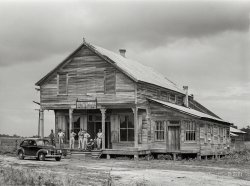
- Steamboat Gothic: 1938
- ... " 'San Francisco,' Reserve vicinity, St. John Parish, Louisiana. Steamboat Gothic circa 1850." 8x10 negative by Frances Benjamin ... Posted by Dave - 10/31/2016 - 8:08pm -
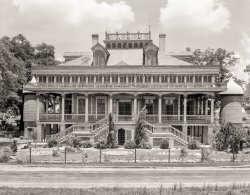
- Saints & Sodas: 1940
- June 1940. "Natchitoches, Louisiana -- drug store." McClung Drug, "Burial place of St. Denis." Medium ... Posted by Dave - 07/11/2019 - 10:10am -
![Saints & Sodas: 1940 June 1940. "Natchitoches, Louisiana -- drug store." McClung Drug, "Burial place of St. Denis." Medium format acetate negative by Marion Post Wolcott. View full size.
Drugs to TchotchkesMcClung Drug is now the Hall Tree, an apparel and gift shop.
[With the same 1930s bronze plaque next to the trash can! - Dave]
Just wonderingMr. McClung, can I get a Pepsi?
Louis Antoine Juchereau de St. DenisHe founded Natchitoches in 1714 and his name is all over town, including a funeral home. He's buried there--in the church, not the drug store.
[Actually he's buried under the drug store. - Dave]
Ultimate remedySaints and Sodas, Cokes and Smokes, but in the end, it's Ex-Lax.
Cokes and smokesthat's all you need.
(The Gallery, Bizarre, M.P. Wolcott, Small Towns, Stores & Markets)](https://www.shorpy.com/files/images/SHORPY-8c12722a.thumbnail.jpg)
- Cajun Girls' Night Out: 1938
- ... October 1938. "Girls from the Cajun country at Raceland, Louisiana." 35mm negative by Russell Lee for the Farm Security Administration. ... Posted by Dave - 04/10/2008 - 9:31pm -
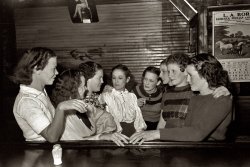
- Behind the Gray Door: 1925
- ... of the world would look like if the french had clung onto Louisiana.
(The Gallery, Arnold Genthe, New Orleans) ... Posted by Dave - 01/12/2015 - 12:39pm -
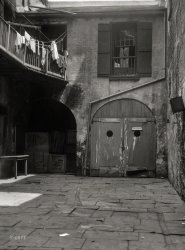
- Good Eats: 1937
- ...
Dressed When I ordered a ham sandwich in Burras, Louisiana (elevation 0') the young lady asked "Would you like that dressed?" ... Posted by Dave - 07/26/2014 - 12:41pm -
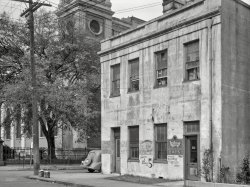
- Bathhouse Row: 1910
- ... that briefly held the surrounding territory after the Louisiana Purchase was made.
Good shot! With most of the frame in focus ... Posted by Dave - 08/15/2012 - 3:07pm -
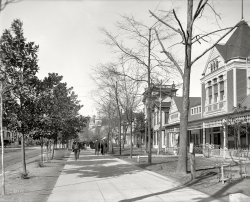
- Or Else: 1938
- October 1938. "Sign at Rice Festival in Crowley, Louisiana." Alternate title: "The Ballad of Competing (and Possibly ... Posted by Dave - 03/22/2012 - 11:07am -
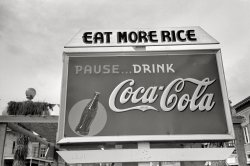
- Magic Show: 1938
- November 1938. Donaldsonville, Louisiana. "Group of people watching magician at state fair." 35mm nitrate ... Posted by Dave - 02/21/2012 - 11:36pm -
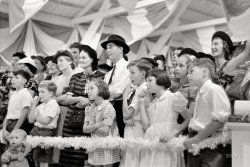
- Junior Hop: 1953
- ... that blossomed in the 50s. -tterrace]
Ha! I was in Louisiana, we missed out on that memo! And I was about 12. HA!
Bracelet of ... Posted by Dave - 07/25/2013 - 2:52am -
![Junior Hop: 1953 1953. "College students attending party with a tropical theme." Photo by Charlotte Brooks for the Look magazine assignment "Junior Hop." View full size.
White Bucks and Paper Dixie CupsI remember wearing white buck shoes. It was one of the main items for that "Ivy League Style". No one would wear them in public until they were properly scuffed up first. Every casual party had paper dixie cups. School year books during this period would usually show students sporting those straw hats for a variety of themed parties such as a Li'l Abner Sadie Hopkins Day Dance.
The guitaristlooks like a young Warren Beatty.
That LooksDownright cozy! Tad early for Belafonte I'd guess, Cugat?
[Even before Belafonte, Calypso music was gaining a following, particularly in New York and also on college campuses, where it became part of the general revival of interest in folk music that blossomed in the 50s. -tterrace]
Ha! I was in Louisiana, we missed out on that memo! And I was about 12. HA!
Bracelet of ???O-Rings? And here we thought Madonna invented that look in 1983. Ha, she did not!
Ah, Golden Youth!...gathered around the, er, flashbulb....
(ShorpyBlog, LOOK, Music)](https://www.shorpy.com/files/images/SHORPY_09459u.thumbnail.jpg)
- Thoroughly Modern: 1922
- ... the sun is probably why he looks so miserable. In rural Louisiana some kids (pre-1970) would keep the young ones as pets until they ... Posted by Dave - 04/18/2016 - 6:18pm -
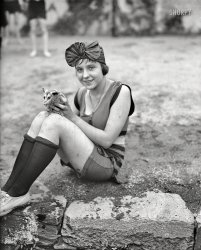
- Howard the Delivery Boy: 1913
- November 1913. Shreveport, Louisiana. Howard Williams, 13-year-old delivery boy for Shreveport Drug ... Posted by Dave - 08/13/2013 - 3:50pm -
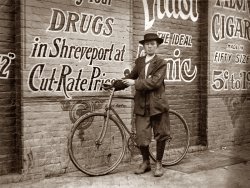
- Kings of the Road: 1940
- ... beside it. On highway near Camp Livingston, Alexandria, Louisiana." Later that day: "Two construction workers who sleep in car, cooking ... Posted by Dave - 07/17/2019 - 1:43pm -
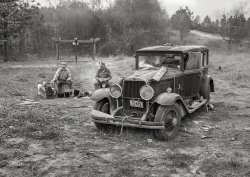
- Army Goods: 1940
- December 1940. Rapides Parish, Louisiana. "Corner building in center of Alexandria showing signs advertising ... Posted by Dave - 07/20/2019 - 12:22pm -
![Army Goods: 1940 December 1940. Rapides Parish, Louisiana. "Corner building in center of Alexandria showing signs advertising Army and military wearing apparel and goods." Medium format acetate negative by Marion Post Wolcott for the Farm Security Administration. View full size.
Barksdale FieldBarksdale Field (now Barksdale AFB) is located near Alexandria, and back in the day, officers would be responsible for buying their own uniforms from tailor shops.
[The principal military outpost here was Camp Livingston, the Army base formerly known as Camp Tioga. - Dave]
Corner of 3rd & Desoto
Ginsberg; Weiss & GoldringThe store formerly known as "B. Ginsberg" (later taken over by Caplan's) still sells uniforms, as demonstrated by the items on display in the front windows on the Google Street View. The name "Weiss & Goldring" remains above the door of the department store building to the right, but according to page 7 this wonderful City of Alexandria downtown talking tour guide, the business moved with its old neon sign after new locations opened in and around the local shopping mall 25 years ago.
https://www.cityofalexandriala.com/sites/default/files/ahpc/docs/walking...
[Do not put brackets around URLs. - Dave]
Camp ClaiborneI was born at Baptist Hospital in Alexandria while my father was stationed at Camp Claiborne, which was just outside Alexandria during WWII. He was shipped to Europe from there and then to Normandy, France. Camp Claiborne no longer exists.
Barksdale AFB is actually located adjacent to Shreveport, quite a way northwest of Alexandria.
(The Gallery, Cars, Trucks, Buses, M.P. Wolcott, Stores & Markets, WW2)](https://www.shorpy.com/files/images/SHORPY-8c14345a.thumbnail.jpg)
- Stranded: 1937
- July 1937. "Man who worked in Fullerton, Louisiana, lumber mill for 15 years. He is now left stranded in the cut-over ... Posted by Dave - 09/09/2011 - 1:36pm -

- Tiny Shucker: 1912
- ... as a thirteen yo female in my family's restaurant in Louisiana. The leverage it takes to break the hinge on the oyster would be ... Posted by Dave - 03/14/2016 - 2:14pm -
![Tiny Shucker: 1912 February 1912. "Tiny, a seven-year-old oyster shucker (sister of Henry, No. 3291), does not go to school. Works steady. Been at it one year. Maggioni Canning Co. Port Royal, South Carolina." Photograph by Lewis Wickes Hine. View full size.
I've consumed many an oysterBut have shucked nary a one. Still, judging from the heavy gloves sturdy adults use when performing that task, I am surprised that this poor little waif has any hands left. I presume, of course, that she hadn't a tiny pair of work gloves, given her obvious place in the socio-economic hierarchy of Port Royal.
Child LaborPoor kid already looks like someone's grandma.
The other side of seafoodNo idea what it's like today, but I saw a lot of how the seafood industry worked in Florida in the mid-1960s. My dad, for a couple of years, was manager of what was at that time the largest seafood company in the U.S. To teach me the value of an education, he arranged for me to work at one of the plants in Marathon, Florida, that "processed" fresh mackerel. Beheading, gutting, and rinsing the fish and putting them into a wire basket was the task when the fishing boats came in, and that began at four in the morning. It took 11 cleaned fish to fill the wire basket, and you got 25 cents a basket. I was supposed to do that for a week; one day was all I could manage and I'll never forget it.
Later, when living in Apalachicola, Florida, I'd go down to the packing plants where older black women shucked oysters. These women were so skilled it was almost beyond belief, and they had worked together so long that it seemed like a social event as they joked and sang and teased each other. That proved, to me, their tough spirit and great skill. The work was not only not fun but tedious and dangerous; handling those peculiar stiff-bladed oyster knives was not something you did without paying attention. I did admire those women so and was proud they accepted me as a friend.
I think a bit misleadingI shucked oysters as a thirteen yo female in my family's restaurant in Louisiana. The leverage it takes to break the hinge on the oyster would be beyond her ability, I would say, but who knows. I would think her job would have been to break apart the clusters of oysters with a hammer to separate them for the shuckers.
[Not misleading. They used knives. She was one of hundreds. - Dave]
(The Gallery, Kids, Lewis Hine)](https://www.shorpy.com/files/images/SHORPY-05335u.thumbnail.jpg)
- Paddy Wagon: 1936
- September 1938. Abbeville, Louisiana. "Farmer's truck at state rice mill." 35mm negative by Russell Lee ... Posted by Dave - 08/09/2012 - 1:29pm -
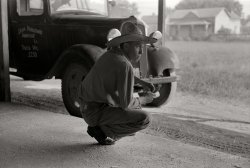
- We Ate the Chickens: 1939
- ... poor family that lived in a palmetto shack near a lake in Louisiana during this time frame. Sometimes all they had to eat was some ... Posted by Dave - 03/27/2018 - 12:13am -
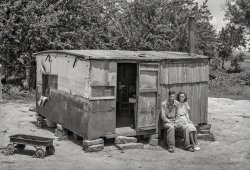
- Amite City: 1935
- October 1935. Young residents of Amite City, Louisiana. View full size. 35mm nitrate negative by Ben Shahn for the Farm ... Posted by Dave - 09/09/2011 - 10:48am -
![Amite City: 1935 October 1935. Young residents of Amite City, Louisiana. View full size. 35mm nitrate negative by Ben Shahn for the Farm Security Administration.
Ben ShahnIs this the Ben Shahn of the famous prints? This photograph has the same look of blunt desperation.
[Yes, Ben Shahn the painter. - Dave]
That Ben ShahnYeah, that Ben Shahn could sure take a picture, couldn't he?
(The Gallery, Ben Shahn, Small Towns)](https://www.shorpy.com/files/images/8a17045u.thumbnail.jpg)
- Chicken to Go: 1923
- Washington, D.C., 1923. "Louisiana Avenue market." And our second glimpse of the Globe Broom Factory ... Price & Company, produce commission merchants, at 933 Louisiana avenue northwest, last night shortly after 9 o'clock.
The fire ... Posted by Dave - 05/18/2014 - 12:06am -
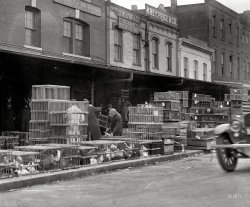
- Fais Do-Dudes: 1938
- ... October 1938. "Men's section at fais-do-do near Crowley, Louisiana. Note ticket taker." View full size. Medium format negative by ... Posted by Dave - 04/18/2008 - 1:54am -
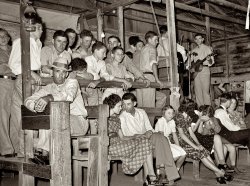
- The Gray Printing Press: 1890
- ... published and edited several newspapers in Morgan City, Louisiana and the area surrounding. He is seen in this picture with three of ... Posted by Miss_Leah_Cather... - 09/06/2007 - 1:16pm -
